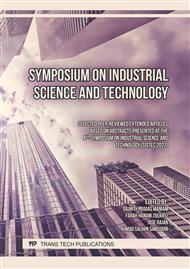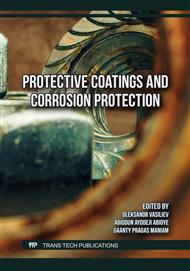[1]
Kötz, R. and M. Carlen, Principles and applications of electrochemical capacitors. Electrochimica Acta, 2000. 45(15): pp.2483-2498.
DOI: 10.1016/s0013-4686(00)00354-6
Google Scholar
[2]
Simon, P. and Y. Gogotsi, Materials for electrochemical capacitors. Nature materials, 2008. 7(11): pp.845-854.
DOI: 10.1038/nmat2297
Google Scholar
[3]
Su, X.-L., et al., Three-dimensional porous activated carbon derived from loofah sponge biomass for supercapacitor applications. Applied Surface Science, 2018. 436: pp.327-336.
DOI: 10.1016/j.apsusc.2017.11.249
Google Scholar
[4]
Aboelazm, E.A.A., et al., Recycling of Cobalt Oxides Electrodes from Spent Lithium-Ion Batteries by Electrochemical Method, in Waste Recycling Technologies for Nanomaterials Manufacturing, A.S.H. Makhlouf and G.A.M. Ali, Editors. 2021, Springer International Publishing: Cham. pp.91-123.
DOI: 10.1007/978-3-030-68031-2_4
Google Scholar
[5]
Ali, G.A., et al., Capacitive performance of cysteamine functionalized carbon nanotubes. Materials Chemistry and Physics, 2017. 197: pp.100-104.
Google Scholar
[6]
Abdelaziz Aboelazm, E.A., et al., Flakes size-dependent optical and electrochemical properties of MoS2. Current Nanoscience, 2018. 14(5): pp.416-420.
DOI: 10.2174/1573413714666180228152602
Google Scholar
[7]
Thirumal, V., et al., Direct growth of multilayered graphene nanofibers by chemical vapour deposition and their binder-free electrodes for symmetric supercapacitor devices. Progress in Organic Coatings, 2021. 161: p.106511.
DOI: 10.1016/j.porgcoat.2021.106511
Google Scholar
[8]
Hosseinzadeh, B., et al., MOF-derived conformal cobalt oxide/C composite material as high-performance electrode in hybrid supercapacitors. Electrochimica Acta, 2021. 389: p.138657.
DOI: 10.1016/j.electacta.2021.138657
Google Scholar
[9]
Naskar, P., et al., Chemical supercapacitors: a review focusing on metallic compounds and conducting polymers. Journal of Materials Chemistry A, 2021. 9(4): pp.1970-2017.
Google Scholar
[10]
Barik, R. and P.P. Ingole, Challenges and prospects of metal sulfide materials for supercapacitors. Current Opinion in Electrochemistry, 2020. 21: pp.327-334.
DOI: 10.1016/j.coelec.2020.03.022
Google Scholar
[11]
Veerakumar, P., et al., Research Progress on Porous Carbon Supported Metal/Metal Oxide Nanomaterials for Supercapacitor Electrode Applications. Industrial & Engineering Chemistry Research, 2020. 59(14): pp.6347-6374.
DOI: 10.1021/acs.iecr.9b06010
Google Scholar
[12]
Aboelazm, E.A.A., et al., Magnetic Electrodeposition of the Hierarchical Cobalt Oxide Nanostructure from Spent Lithium-Ion Batteries: Its Application as a Supercapacitor Electrode. The Journal of Physical Chemistry C, 2018. 122(23): pp.12200-12206.
DOI: 10.1021/acs.jpcc.8b03306
Google Scholar
[13]
Aboelazm, E.A., G.A. Ali, and K.F. Chong, Cobalt oxide supercapacitor electrode recovered from spent lithium-ion battery. Chemistry of Advanced Materials, 2018. 3(4).
Google Scholar
[14]
Thalji, M.R., et al., Al3+ ion intercalation pseudocapacitance study of W18O49 nanostructure. Journal of Power Sources, 2019. 438: p.227028.
DOI: 10.1016/j.jpowsour.2019.227028
Google Scholar
[15]
HO, M.Y., et al., A Review Of Metal Oxide Composite Electrode Materials For Electrochemical Capacitors. Nano, 2014. 09(06): p.1430002.
DOI: 10.1142/s1793292014300023
Google Scholar
[16]
Thalji, M.R., et al., W18O49 nanowires-graphene nanocomposite for asymmetric supercapacitors employing AlCl3 aqueous electrolyte. Chemical Engineering Journal, 2021. 409: p.128216.
DOI: 10.1016/j.cej.2020.128216
Google Scholar
[17]
Ali, G.A., et al., One-step electrosynthesis of MnO2/rGO nanocomposite and its enhanced electrochemical performance. Ceramics International, 2018. 44(7): pp.7799-7807.
DOI: 10.1016/j.ceramint.2018.01.212
Google Scholar
[18]
Salunkhe, R.R., et al., Fabrication of asymmetric supercapacitors based on coordination polymer derived nanoporous materials. Electrochimica Acta, 2015. 183: pp.94-99.
DOI: 10.1016/j.electacta.2015.05.034
Google Scholar
[19]
Sundriyal, S., et al., Metal-organic frameworks and their composites as efficient electrodes for supercapacitor applications. Coordination Chemistry Reviews, 2018. 369: pp.15-38.
DOI: 10.1016/j.ccr.2018.04.018
Google Scholar
[20]
Hegazy, M.B.Z., et al., Synergistic electrocatalytic hydrogen evolution in Ni/NiS nanoparticles wrapped in multi-heteroatom-doped reduced graphene oxide nanosheets. ACS Applied Materials & Interfaces, 2021. 13(29): pp.34043-34052.
DOI: 10.1021/acsami.1c05888
Google Scholar
[21]
Alowasheeir, A., et al., In-situ formation of Cu–Ni cyano-bridged coordination polymer on graphene oxide nanosheets and their thermal conversion. Microporous and Mesoporous Materials, 2019. 290: p.109670.
DOI: 10.1016/j.micromeso.2019.109670
Google Scholar
[22]
Carvalho, C.L.C., et al., New Hybrid Nanomaterial Based on Self-Assembly of Cyclodextrins and Cobalt Prussian Blue Analogue Nanocubes. International Journal of Molecular Sciences, 2015. 16(7): pp.14594-14607.
DOI: 10.3390/ijms160714594
Google Scholar
[23]
Zakaria, M.B., et al., Layer-by-Layer Motif Heteroarchitecturing of N,S-Codoped Reduced Graphene Oxide-Wrapped Ni/NiS Nanoparticles for the Electrochemical Oxidation of Water. ChemSusChem, 2020. 13(12): pp.3269-3276.
DOI: 10.1002/cssc.202000159
Google Scholar
[24]
Zakaria, M.B., et al., Dual-Heteroatom-Doped Reduced Graphene Oxide Sheets Conjoined CoNi-Based Carbide and Sulfide Nanoparticles for Efficient Oxygen Evolution Reaction. ACS Applied Materials & Interfaces, 2020. 12(36): pp.40186-40193.
DOI: 10.1021/acsami.0c06141
Google Scholar
[25]
El-Gendy, A.A., et al., Enhanced magnetic anisotropy in cobalt-carbide nanoparticles. Applied Physics Letters, 2014. 104(2): p.023111.
DOI: 10.1063/1.4862260
Google Scholar
[26]
Jiao, X., et al., Comparison of the characteristic properties of reduced graphene oxides synthesized from natural graphites with different graphitization degrees. RSC Advances, 2017. 7(82): pp.52337-52344.
DOI: 10.1039/c7ra10809e
Google Scholar
[27]
Bharath, G., et al., Sunlight-Induced photochemical synthesis of Au nanodots on α-Fe2O3@Reduced graphene oxide nanocomposite and their enhanced heterogeneous catalytic properties. Scientific Reports, 2018. 8(1): p.5718.
DOI: 10.1038/s41598-018-24066-y
Google Scholar
[28]
Kim, S.-G., et al., Layer-by-layer assembled graphene oxide films and barrier properties of thermally reduced graphene oxide membranes. Carbon letters, 2013. 14(4): pp.247-250.
DOI: 10.5714/cl.2013.14.4.247
Google Scholar
[29]
Chen, L., et al., Construction of CoNi2S4 hollow cube structures for excellent performance asymmetric supercapacitors. Applied Surface Science, 2021. 570: p.151174.
DOI: 10.1016/j.apsusc.2021.151174
Google Scholar
[30]
Villalva‐Mejorada, D.I., et al., Mixed cobalt–zinc hexacyanoferrate hollow micro‐cubes for a high‐voltage hybrid supercapacitor. International Journal of Energy Research, 2022.
DOI: 10.1002/er.8629
Google Scholar
[31]
Mai, L., et al., Fast Ionic Diffusion-Enabled Nanoflake Electrode by Spontaneous Electrochemical Pre-Intercalation for High-Performance Supercapacitor. Scientific Reports, 2013. 3(1): p.1718.
DOI: 10.1038/srep01718
Google Scholar
[32]
Azhar, A., et al., Graphene‐Wrapped Nanoporous Nickel‐Cobalt Oxide Flakes for Electrochemical Supercapacitors. ChemistrySelect, 2018. 3(29): pp.8505-8510.
DOI: 10.1002/slct.201801174
Google Scholar
[33]
Ali, G.A., et al., Co3O4/SiO2 nanocomposites for supercapacitor application. Journal of Solid State Electrochemistry, 2014. 18(9): pp.2505-2512.
DOI: 10.1007/s10008-014-2510-3
Google Scholar
[34]
Das, S., et al., High-frequency electrochemical double layer capacitor based on carbon nanotubes ink coated eggshell membrane electrodes. Journal of Energy Storage, 2022. 45: p.103799.
DOI: 10.1016/j.est.2021.103799
Google Scholar



